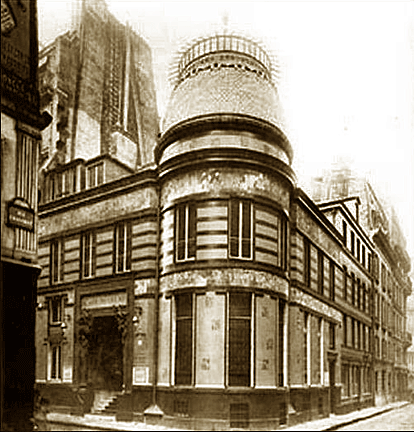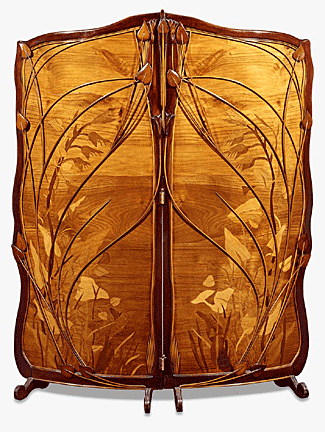|
The
Quest for Artistic Furniture
by
Bob Brooke
 As
the Victorian Era of the 19th century transitioned into the modern era
of the 20th, a new style burst on the scene—a total style that
encompassed everything from architecture to furniture to accessories.
Known as Art Nouveau or Jugendstil, it was an international philosophy
and style of art and applied art—especially the decorative arts—that was
popular from about 1890 to 1910. Art nouveau literally means "new art"
in French. As
the Victorian Era of the 19th century transitioned into the modern era
of the 20th, a new style burst on the scene—a total style that
encompassed everything from architecture to furniture to accessories.
Known as Art Nouveau or Jugendstil, it was an international philosophy
and style of art and applied art—especially the decorative arts—that was
popular from about 1890 to 1910. Art nouveau literally means "new art"
in French.
The new style was an outgrowth of two19th-century English movements—the
Arts and Crafts and the Aesthetic Movements. The former emphasized a
return to handcraftsmanship and traditional techniques. The latter
promoted “art for art’s sake” a concept that applied to abstract
paintings. It further drew upon elements of Japanese art or “japonisme,”
which flooded Western markets, mainly in the form of prints, after the
U.S. established trading rights with Japan in the 1860s.
 Maison
de l'Art Nouveau, or the House of New Art, was the name of the gallery
opened by German art dealer Siegfried Bing in 1895 that featured modern
art exclusively. In 1900, he produced an exhibition of color-coordinated
modern furniture, tapestries, and objets d’art for the Exposition
Universelle in Paris, which captured the imagination of visitors.
Because his decorative displays became so strongly associated with this
style, the style, itself, took on the name of his gallery, "Art
Nouveau." Maison
de l'Art Nouveau, or the House of New Art, was the name of the gallery
opened by German art dealer Siegfried Bing in 1895 that featured modern
art exclusively. In 1900, he produced an exhibition of color-coordinated
modern furniture, tapestries, and objets d’art for the Exposition
Universelle in Paris, which captured the imagination of visitors.
Because his decorative displays became so strongly associated with this
style, the style, itself, took on the name of his gallery, "Art
Nouveau."
Though antiques experts credit Bing’s gallery for the popularization of
the movement and its name, the Art Nouveau style reached an
international audience through the vibrant graphic arts printed in such
periodicals as The Savoy, La Plume, Jugend, Dekorative Kunst, The Yellow
Book, and The Studio.
 The
style became especially associated with France, where it was known as
variously Style Jules Verne, Le Style Métro, Art belle époque, and Art
fin de siè. However, even though the Art Nouveau style was most popular
in Europe, its influence was global. Before the term "Art Nouveau"
became common in France, le style moderne, or "the modern style," was
how people referred to it. It went by similar designations all across
the continent—Arte joven in Spain, Modernisme in Catalonia, Arte nova in
Portugal, Arte nuova in Italy, and Nieuwe kunst in the Netherlands—all
essentially meaning “new art.” The
style became especially associated with France, where it was known as
variously Style Jules Verne, Le Style Métro, Art belle époque, and Art
fin de siè. However, even though the Art Nouveau style was most popular
in Europe, its influence was global. Before the term "Art Nouveau"
became common in France, le style moderne, or "the modern style," was
how people referred to it. It went by similar designations all across
the continent—Arte joven in Spain, Modernisme in Catalonia, Arte nova in
Portugal, Arte nuova in Italy, and Nieuwe kunst in the Netherlands—all
essentially meaning “new art.”
The origins of Art Nouveau can be traced back to the resistance of
William Morris to the cluttered compositions and the revivals of the
19th century and his theories that helped start the Arts and Crafts
Movement. The flat perspective and strong colors of Japanese wood block
prints, especially those of Katsushika Hokusai, also had a strong effect
on the formulation of Art Nouveau. Hokusai’s references to the natural
world influenced many artists and designers fro the 1880s through the
1890s.
 Art
Nouveau was a "total" art style, embracing architecture, graphic art,
interior design, and most of the decorative arts including jewelry,
furniture, textiles, household silver and other utensils and lighting.
Artists strove to combine the fine arts and applied arts, even for
utilitarian objects, such as tableware, cigarette cases, and silverware.
Art historians consider it an important transition between the eclectic
historic revival styles of the 19th-century and Modernism. Art
Nouveau was a "total" art style, embracing architecture, graphic art,
interior design, and most of the decorative arts including jewelry,
furniture, textiles, household silver and other utensils and lighting.
Artists strove to combine the fine arts and applied arts, even for
utilitarian objects, such as tableware, cigarette cases, and silverware.
Art historians consider it an important transition between the eclectic
historic revival styles of the 19th-century and Modernism.
Three international art exhibitions—the Barcelona Universal Exposition
of 1888, the Exposition Universelle of 1900 in Paris, and the
Esposizione Internazionale d'Arte Decorativa Moderna of 1902 in Turin,
Italy— showcased an overview of this modern style in every medium.
 Though
the Art Nouveau was innovative, it didn’t last long. It was important in
American furniture history, however, because it rebelled against the
overembellished furniture of the Victorian Era. Some furniture makers
began designing furniture and accessories with simple, flowing, fluid
lines, taking their cues from nature, with its motion and curves.
Fairylike tendrils wove in, out, and around the leaves and stems of
flowers, fruit, and nuts. Foaming ocean waves broke over nude women, and
graceful tree branches swept the earth. The entire effect was one of
delicate sensuality and naturalness, with faint overtones of sentimental
decadence. Though
the Art Nouveau was innovative, it didn’t last long. It was important in
American furniture history, however, because it rebelled against the
overembellished furniture of the Victorian Era. Some furniture makers
began designing furniture and accessories with simple, flowing, fluid
lines, taking their cues from nature, with its motion and curves.
Fairylike tendrils wove in, out, and around the leaves and stems of
flowers, fruit, and nuts. Foaming ocean waves broke over nude women, and
graceful tree branches swept the earth. The entire effect was one of
delicate sensuality and naturalness, with faint overtones of sentimental
decadence.
And although Art Nouveau furniture designers selected and “modernized”
some of the more abstract elements of the Rococo style, such as flame
and shell textures, they also
 advocated
the use of very stylized organic forms, expanding the “natural”
repertoire to use seaweed, grasses, and insects. advocated
the use of very stylized organic forms, expanding the “natural”
repertoire to use seaweed, grasses, and insects.
But unlike the craftsman-oriented Arts and Crafts Movement, the artists
of the Art Nouveau Movement used new materials, machined surfaces, and
abstraction in their designs. The stylized nature of Art Nouveau design
made it expensive to produce, therefore, only the wealthy could afford
it. Unlike furniture handmade by the craftsmen of the Arts and Crafts
Movement, that of the Art Nouveau Movement was produced in factories by
normal manufacturing techniques. Finishes were highly polished or
varnished, and designs in general were usually complex, with curving
shapes.
 Several
notable designers of Art Nouveau furniture were architects who designed
furniture for specific buildings they had also designed, a way of
working inherited from the Arts and Crafts movement; these include
Charles Rennie Mackintosh, Antoni Gaudí, Hector Guimard and Victor Horta.
Mackintosh's furniture was relatively austere and geometrical, marked by
elongated dimensions and right-angles. Continental designs were much
more elaborate, often using curved shapes both in the basic shapes of
the piece, and in applied decorative motifs. In many ways the old
vocabulary and techniques of classic French 18th-century Rococo
furniture were re-interpreted in a new style. Luxury veneers were used
in the furniture of leading cabinetmakers Georges de Feure and others. Several
notable designers of Art Nouveau furniture were architects who designed
furniture for specific buildings they had also designed, a way of
working inherited from the Arts and Crafts movement; these include
Charles Rennie Mackintosh, Antoni Gaudí, Hector Guimard and Victor Horta.
Mackintosh's furniture was relatively austere and geometrical, marked by
elongated dimensions and right-angles. Continental designs were much
more elaborate, often using curved shapes both in the basic shapes of
the piece, and in applied decorative motifs. In many ways the old
vocabulary and techniques of classic French 18th-century Rococo
furniture were re-interpreted in a new style. Luxury veneers were used
in the furniture of leading cabinetmakers Georges de Feure and others.
But Art Nouveau found its greatest expression in accessories, not
furniture. This was the era of Louis Comfort Tiffany and other designers
who worked in glass, china, pottery, and metal. Those substances were
far easier to shape into the undulating
 styles
of the time than was wood. Most wooden furniture during this time was
custom-made and therefore usually of good quality and fine woods,
featuring asymmetrical lines, as well as stylized animal and plant
forms. styles
of the time than was wood. Most wooden furniture during this time was
custom-made and therefore usually of good quality and fine woods,
featuring asymmetrical lines, as well as stylized animal and plant
forms.
It also tended to be expensive, as furniture makers regarded a fine
finish, usually polished or varnished, as essential, and continental
designs featured complex, curving shapes that were expensive to produce.
It by no means entirely replaced other styles of furniture, which
continued to be popular, with Art Nouveau styles largely restricted to
an expensive "art furniture" category. French and Belgian furniture
designers embraced the style with more enthusiasm than those in other
countries.
<
Back to Antiques Archives
Next Article >
|
